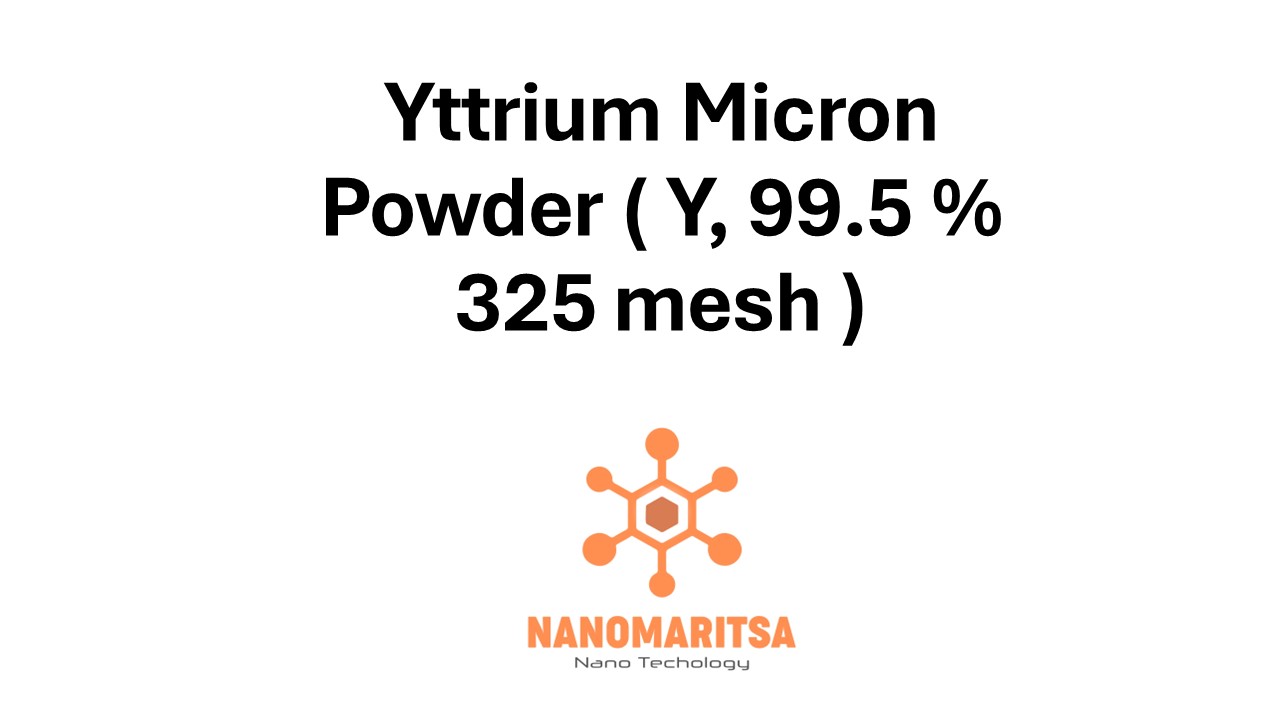Yttrium Micron Powder (Y, 99.5%, 325 Mesh) is a high-purity form of yttrium metal powder whose particles pass through a 325-mesh sieve (approximately 44 micrometers or finer). Yttrium is classified as a rare-earth metal and is widely valued for its role in advanced ceramics, phosphors, superconductors, and alloy systems. Its moderate density, good thermal stability, and ability to enhance the properties of other materials make yttrium an important metal in cutting-edge technologies ranging from solid oxide fuel cells to laser crystals.
1. Key Properties
- High Purity (99.5%)
This purity level minimizes unwanted impurities that could otherwise hamper performance in sensitive applications, such as electronics, precision ceramics, and specialty alloys. - Fine Particle Size (325 Mesh)
Particles passing through a 325-mesh sieve provide a relatively large surface area, which is beneficial for uniform mixing in composites, improved sintering in ceramics, and consistent behavior in metallurgical processes. - Thermal Stability
Yttrium maintains its structural integrity at elevated temperatures, making it suitable for high-temperature alloys, coatings, and advanced ceramic formulations. - Rare-Earth Characteristics
As a rare-earth element, yttrium often plays a key role in modifying optical, electrical, or mechanical properties of host materials, enabling high-performance systems in numerous industries. - Reactive Behavior
In powdered form, yttrium can be reactive in air and moisture, which is why it typically requires controlled environments during storage and processing.
2. Applications
- Advanced Ceramics & Refractories
Yttrium oxide (Y₂O₃) and yttrium-stabilized zirconia (YSZ) are known for their high toughness and thermal shock resistance, critical in aerospace, medical implants, and solid oxide fuel cells. - Phosphors & Displays
Yttrium compounds serve as host materials for phosphors used in cathode-ray tube displays, LEDs, and other lighting systems, providing bright, stable emission spectra. - Alloy Additive
Small additions of yttrium can refine grain structure, improve oxidation resistance, and enhance mechanical properties in alloys such as magnesium or aluminum-based systems. - Laser Crystals & Garnets
Yttrium aluminum garnet (YAG) is a common host crystal for solid-state lasers, supporting precise and high-intensity laser outputs for industrial cutting, medical procedures, and research instrumentation. - Superconductors
Yttrium-based high-temperature superconductors (e.g., YBCO) exhibit zero electrical resistance above the boiling point of liquid nitrogen, enabling powerful magnets and energy-efficient electrical systems.
3. Advantages
- Enhanced Mechanical Performance
Even minor additions of yttrium in alloys can significantly boost mechanical strength, creep resistance, and overall longevity under demanding conditions. - Improved Oxidation & Corrosion Resistance
Yttrium-containing protective coatings and oxide layers stand up to harsh environments, such as high-temperature furnace components or chemical processing equipment. - High-Temperature Resilience
Yttrium-based materials maintain structural integrity at elevated temperatures, reducing thermal fatigue and improving reliability in applications like turbine engines and plasma-facing reactor parts. - Efficient Material Doping
Because yttrium is a rare-earth element, small dopant levels can profoundly modify optical and electrical properties, making it a powerful tool for tuning material performance. - Versatile Manufacturing
The sub-44 µm particle size (passing 325 mesh) is suitable for powder metallurgy, ceramic pressing, thermal spraying, and other manufacturing routes requiring fine, consistent powders.
4. Recent Trends and Research
- Solid Oxide Fuel Cells (SOFCs)
Research focuses on yttria-stabilized zirconia electrolytes, improving ionic conductivity and durability for high-efficiency power generation in stationary and portable energy systems. - Advanced Laser Materials
Ongoing innovations in crystal growth and doping techniques are broadening the applications of YAG and other yttrium-based hosts in medical, industrial, and military lasers. - High-Temperature Ceramics
Scientists are engineering yttrium-containing ceramics with exceptional thermal shock resistance for spacecraft heat shields, hypersonic vehicles, and next-generation combustion engines. - Sustainability & Recycling
Efforts to reclaim yttrium from end-of-life phosphors, electronics, and other waste streams are growing as industries seek to secure supply chains and reduce environmental impacts. - Energy Storage & Catalysis
Investigations into yttrium’s catalytic behavior are exploring potential roles in hydrogen production, advanced battery chemistries, and ammonia synthesis.
5. Future Prospects
- Emerging Fuel Cell Technologies
As fuel cell adoption expands, yttrium’s role in stabilizing zirconia for durable, high-performance electrolytes will become increasingly critical. - Next-Generation Lasers & Photonics
Yttrium-based materials will continue to support more powerful, efficient laser systems for cutting, welding, and precision medical treatments. - Aerospace & Hypersonic Applications
High-temperature structural ceramics and coatings containing yttrium could advance propulsion technologies, improving flight efficiency and component lifespan. - Lightweight, High-Strength Alloys
Automotive and aerospace designers will further explore yttrium-doped aluminum or magnesium alloys to reduce weight while enhancing corrosion and creep resistance. - High-Volume Recycling Initiatives
As use of yttrium increases, scalable recycling methods will be essential for lowering raw material costs and meeting environmental mandates on resource sustainability.
Through its 99.5% purity, fine particle size (passing 325 mesh), and unique rare-earth properties, Yttrium Micron Powder (Y, 99.5%, 325 Mesh) stands as a strategic material in advanced ceramics, metallurgical enhancements, laser technology, and more. Its ability to modify and improve the performance of host systems underlines yttrium’s rising importance in a world demanding stronger, lighter, and more efficient materials.
| Measurement (gr) | 100 grams, 500 grams, 1000 grams |
|---|






